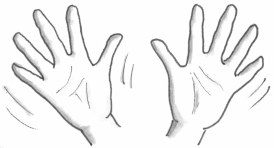Designing Collaborative Workshops
Working with Large Groups
Working with large groups can involve different challenges to more intimate workshops. Sometimes these large group work is broken up into different sections to make it more manageable. Events organised in this way can be called BarCamps, Unconferences or Open Spaces.
Example 1: A warm up for large groups - Rain making
This is a lovely co-operative game that always brings a group together and lights up people's faces! Ask everyone to gather around you in a tight semi-circle, several people deep. Divide the semi-circle into three groups. Explain that you're all going to create a rainstorm by making four simple sounds in a round. The sounds are as follows... People playing the rain game
- Drizzle - gently rub your palms together to produce a whispering sound.
- Light rain - move your hands up and down in opposite directions, with the palms brushing against each other, as if you are brushing sand off the palms.
- Heavy rain - clap your hands together.
- Hail - cup your palms and clap them against your thighs.
Start off group one on making drizzle. Once that's under way turn and signal to group two to start with drizzle, then group three. Turn back to group 1 and get them to start light rain whilst the other maintain their drizzle, then turn to group two and do the same, then group three. Keep the round alive until all segments are making hail. Then work backwards so that group one stop hailing and make heavy rain, then two, then three, until you work back through light rain to drizzle and then silence!
From http://www.seedsforchange.org.uk/tools
Example 2: Introduce the Law of 2 Feet.
(NB: if any participant doesn't have two feet, it might be more sensitive to rename it as the Law of Personal Responsibility). “Don't find yourself stuck in a conversation that's neither dynamic, creative nor useful for you. Open Space gives us full permission to use our feet and move whenever and wherever we want. Remember it's a self- organised space.”
Example 3: Hand signals
Handsignals are a simple technique that can make larger workshops and meetings run more smoothly and help the facilitator see emerging agreements and common ground. Three simple signals usually suffice:

Raise a forefinger when you wish to contribute to the discussion with a general point.

Raise both forefingers if your point is a direct response to a point that's just been made or a question that's just been asked. This allows you to jump to the head of the queue, in front of all those people raising just one finger. Use wisely and discourage overuse!

Silent applause - when you hear an opinion that you agree with, wave a hand with your fingers pointing upwards (this saves a lot of time as people don't need to chip in to say “I'd just like to add that I agree with...”). You can signal disagreement with a downward wave of the fingers.
Sometimes with big, diverse or difficult groups more hand signals can be useful. Take a look at the Seeds for change briefing Hand Signals for different examples of usage and clear explanations of what they can do.
From http://www.openspaceworld.com/users_guide.htm
Example 4: Bumblebees and butterflies.
There are also 2 roles that are particularly noticeable in large groups.

Bumblebees move from one conversation to the next, cross-pollinating between them. There's no need to stick with one conversation for the full time – remember the Law of 2 Feet and move whenever that works for you.
Butterflies appear to be sunning themselves, often hanging around by the refreshments. They may decide never to attend a formal conversation throughout the whole Open Space. And that's fine. Open Space came about as people recognised the value of the informal interactions they had at conferences, over meals and coffee breaks, in corridors, and the butterflies keep that possibility alive in Open Space.”
The Law of 2 Feet and Bumblebees / Butterflies resources are from http://rhizomenetwork.wordpress.com/resources/
Example 5: Facilitator Guidelines by Aspiration Tech / CC BY-SA
The following are an example of guidelines provided to session facilitators. They are offered as input for facilitators as they consider to guide their sessions; facilitators will obviously have the final say in how the sessions transpire.
A primary goal of Aspiration events is to let the participants drive the dialog. The concern is less with information transfer and more focused instead on maximizing social interaction; when friendships are established, that drives knowledge sharing long after the event.
Facilitators are invited to envision themselves as catalysts in this process, and to consider the following suggestions for structuring their sessions:
- Call out the goals for each discussion at the outset, check along the way that you are progressing towards those goals, and review the goals at the end of the session. This is sometimes referred to as the “tell them what you're going to tell them, then tell them, then tell them what you told them†model.
- If group size is not excessive, consider doing a quick go-round where each participant can state in a sentence or two what they hope to get out of the session. This helps to both establish the level and range of knowledge in the group, as well as inform and focus the discussion.
- Strive to include everyone in the circle. Some participants will want to talk too much, others will refrain from speaking. Try to move the dialog to the latter camp, and don't be shy about politely calling out those who monopolize the airwaves
- Avoid long presentations, and instead aim to establish context and open the floor for discussion. There will be great wisdom and experience in every circle, and letting that flow leads to great serendipities
- Avoid Powerpoint or other “slideware†whenever possible. While visual aids have unquestioned value, slides put people in “TV-watching†mode, diminishing their instinct to participate.
- Watch for tangents that de-focus the topic at hand; rope in the digressors and those with a penchant for monologue. Other participants will appreciate this greatly.
- Summarize at the end of each session, checking back against the goals you defined at the outset
- Overall, use your wisdom and passion as your guide; we greatly appreciate facilitators sharing their time and knowledge with the group, and trust each facilitator to create an optimal sharing environment.
Task: How will you manage your large group?
Pick which activities or methods above you will employ should your group become too big to handle. Considering your workshop topic and potential participants, how well do you think this will work? Why?